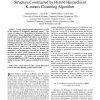BIBM
2008
IEEE
14 years 6 months ago
2008
IEEE
We propose a novel approach for predicting protein functions of an organism by coupling sequence homology and PPI data between two (or more) species with multifunctional Gene Onto...
BIBM
2008
IEEE
14 years 6 months ago
2008
IEEE
Flow cytometry technique produces large, multidimensional datasets of properties of individual cells that are helpful for biomedical science and clinical research. This paper expl...
BIBM
2008
IEEE
14 years 6 months ago
2008
IEEE
Many characteristics of functional synthetic siRNAs have been identified. Our three-phase algorithm was developed to design siRNA on a wholegenome scale based on these characteris...
BIBM
2008
IEEE
14 years 6 months ago
2008
IEEE
Mapping B-cell epitopes plays an important role in vaccine design, immunodiagnostic tests, and antibody production. Because the experimental determination of B-cell epitopes is ti...
BIBM
2008
IEEE
14 years 6 months ago
2008
IEEE
Using microarray technology for genetic analysis in biological experiments requires computationally intensive tools to interpret results. The main objective here is to develop a â...
BIBM
2008
IEEE
14 years 6 months ago
2008
IEEE
— Protein sequence motifs information is crucial to the analysis of biologically significant regions. The conserved regions have the potential to determine the role of the protei...
BIBM
2008
IEEE
14 years 6 months ago
2008
IEEE
Alternative splicing is a mechanism for generating different gene transcripts (called isoforms) from the same genomic sequence. Finding alternative splicing events experimentally ...
BIBM
2008
IEEE
14 years 6 months ago
2008
IEEE
Background: Gene expression signatures in the mammalian brain hold the key to understanding neural development and neurological disease. Researchers have previously used voxelatio...
BIBM
2008
IEEE
14 years 6 months ago
2008
IEEE
Abstract—Biological clock, a self sustaining oscillation widely discovered in many species, is important to determine many biological activities, for example, the sleep-wake cycl...
BIBM
2008
IEEE
14 years 6 months ago
2008
IEEE





